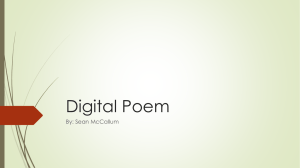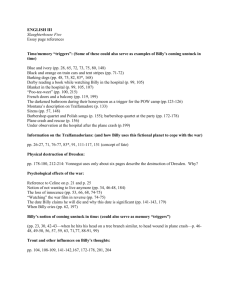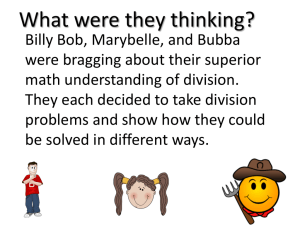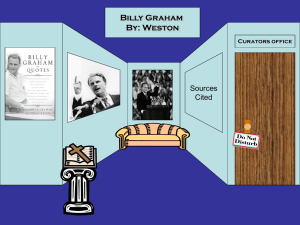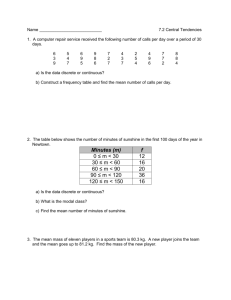Practice with the perspectives
advertisement
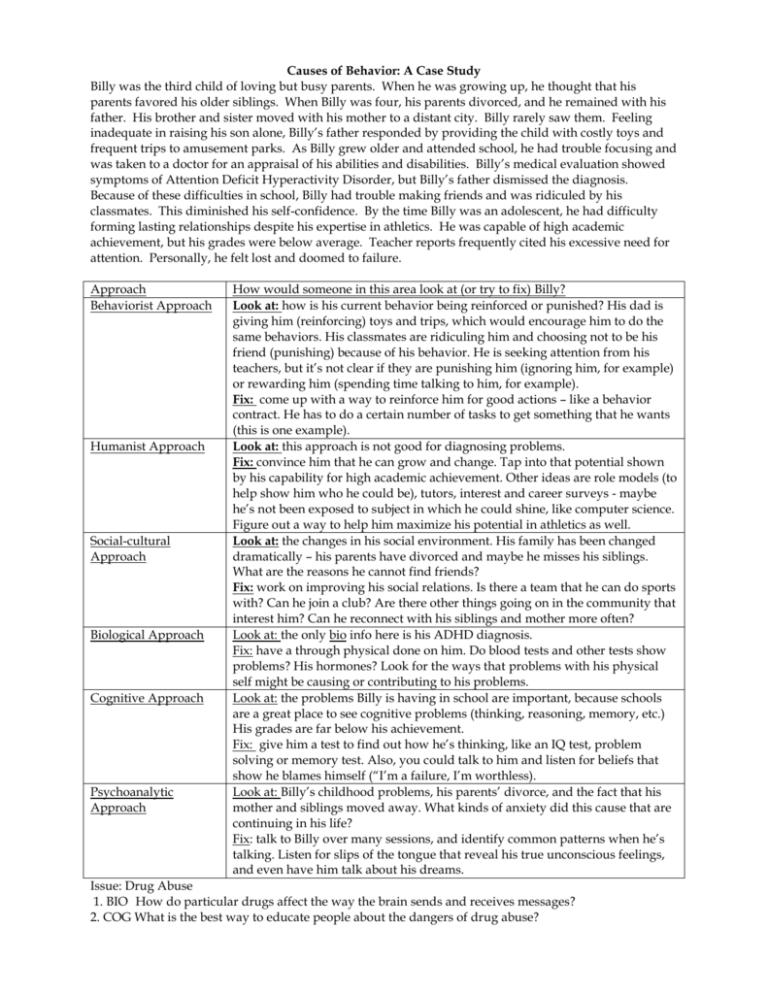
Causes of Behavior: A Case Study
Billy was the third child of loving but busy parents. When he was growing up, he thought that his
parents favored his older siblings. When Billy was four, his parents divorced, and he remained with his
father. His brother and sister moved with his mother to a distant city. Billy rarely saw them. Feeling
inadequate in raising his son alone, Billy’s father responded by providing the child with costly toys and
frequent trips to amusement parks. As Billy grew older and attended school, he had trouble focusing and
was taken to a doctor for an appraisal of his abilities and disabilities. Billy’s medical evaluation showed
symptoms of Attention Deficit Hyperactivity Disorder, but Billy’s father dismissed the diagnosis.
Because of these difficulties in school, Billy had trouble making friends and was ridiculed by his
classmates. This diminished his self-confidence. By the time Billy was an adolescent, he had difficulty
forming lasting relationships despite his expertise in athletics. He was capable of high academic
achievement, but his grades were below average. Teacher reports frequently cited his excessive need for
attention. Personally, he felt lost and doomed to failure.
Approach
Behaviorist Approach
Humanist Approach
Social-cultural
Approach
Biological Approach
Cognitive Approach
Psychoanalytic
Approach
How would someone in this area look at (or try to fix) Billy?
Look at: how is his current behavior being reinforced or punished? His dad is
giving him (reinforcing) toys and trips, which would encourage him to do the
same behaviors. His classmates are ridiculing him and choosing not to be his
friend (punishing) because of his behavior. He is seeking attention from his
teachers, but it’s not clear if they are punishing him (ignoring him, for example)
or rewarding him (spending time talking to him, for example).
Fix: come up with a way to reinforce him for good actions – like a behavior
contract. He has to do a certain number of tasks to get something that he wants
(this is one example).
Look at: this approach is not good for diagnosing problems.
Fix: convince him that he can grow and change. Tap into that potential shown
by his capability for high academic achievement. Other ideas are role models (to
help show him who he could be), tutors, interest and career surveys - maybe
he’s not been exposed to subject in which he could shine, like computer science.
Figure out a way to help him maximize his potential in athletics as well.
Look at: the changes in his social environment. His family has been changed
dramatically – his parents have divorced and maybe he misses his siblings.
What are the reasons he cannot find friends?
Fix: work on improving his social relations. Is there a team that he can do sports
with? Can he join a club? Are there other things going on in the community that
interest him? Can he reconnect with his siblings and mother more often?
Look at: the only bio info here is his ADHD diagnosis.
Fix: have a through physical done on him. Do blood tests and other tests show
problems? His hormones? Look for the ways that problems with his physical
self might be causing or contributing to his problems.
Look at: the problems Billy is having in school are important, because schools
are a great place to see cognitive problems (thinking, reasoning, memory, etc.)
His grades are far below his achievement.
Fix: give him a test to find out how he’s thinking, like an IQ test, problem
solving or memory test. Also, you could talk to him and listen for beliefs that
show he blames himself (“I’m a failure, I’m worthless).
Look at: Billy’s childhood problems, his parents’ divorce, and the fact that his
mother and siblings moved away. What kinds of anxiety did this cause that are
continuing in his life?
Fix: talk to Billy over many sessions, and identify common patterns when he’s
talking. Listen for slips of the tongue that reveal his true unconscious feelings,
and even have him talk about his dreams.
Issue: Drug Abuse
1. BIO How do particular drugs affect the way the brain sends and receives messages?
2. COG What is the best way to educate people about the dangers of drug abuse?
3. SOC How important are role models in developing addictive behaviors?
4. COG How did individuals determine the risk of drug use?
5. SOC Why is the rate of alcoholism higher in the United States than in Sweden?
6. PSY Does unconscious conflict manifest itself in the abuse of illegal substances?
7. __________________What reinforces a teenager who chooses to try heroin?
Issue: Love
8. SOC How are dating/courtship rituals different in different cultures?
9. COG How might loving someone change the way we interpret that person's actions?
10. SOC How do we learn socially appropriate ways to express love?
11. BIO Are there drugs that could really be a “love potion?”
12. HUM Will I find someone who will accept me for the real me – so I won’t have to
pretend?
13. BIO What neurotransmitters are involved in our experience of love?
14. PSY Do the effects of repressed childhood relationship (child/parent) problems
impact our ability to love as adults?
15. COG How is thinking different when a person is in love?
Issue: Intelligence
16. BEH What rewards are most effective in promoting learning?
17. SOC How do some individuals from impoverished backgrounds overcome these
conditions to have successful, productive lives?
18. COG Is there any difference in the way that highly intelligent individuals store and
retrieve information?
19. COG How might an educational system be designed to encourage effective learning
strategies?
20. BIO Do differences in brain structures account for differences in intellectual
abilities?
Key word are in italics!
a) biological
c) behavioral
b) evolutionary
d) social-cultural
e) psychoanalytic
f) humanistic
g) cognitive
a) biological 1. Professor Lopez believes that severe depression results primarily from an imbalanced diet
and abnormal brain chemistry. Professor Lopez favors a _____ perspective on depression.
e) psychoanalytic 2. A clinical psychologist who explains behavior in terms of unconscious drives and
conflicts is employing a(n) ________ perspective.
d) social-cultural 3. Dr. Wilson attributes the delinquent behaviors of many teens to the pressures
associated with being members of street gangs. Her account best illustrates a(n) ________ perspective.
b) evolutionary 4. Professor Crisman believes that most women prefer tall and physically strong partners
because this preference enhanced the survival of our ancestors' genes. This viewpoint best illustrates the
___ perspective.
e) psychoanalytic 5. Dr. Wrenn feels the best method to solving the psychological concerns is to get them
to relax and talk freely about their problems. He hopes that over time he will be able to gain real insight
to the problems in their past that still affect them today.
c) behavioral 6. Mrs. Thompson believes that her son has become an excellent student because she uses
praise and affection to stimulate his learning. Her belief best illustrates a ________ perspective. {She is
rewarding him with praise and affection.]
g) cognitive 7. Dr. MacPherson believes that the way students organize and think about the information
in their textbooks will strongly influence their ability to later remember and use what they have studied.
Dr. MacPherson's ideas most directly exemplify the ________ perspective.
b) evolutionary 8. Mark believes that people are genetically predisposed to dislike bitter-tasting foods
because this has enhanced human survival. His belief best illustrates the ______ perspective.
g) cognitive 9. A concern with the reasoning processes that contribute to effective problem solving is most
characteristic of the ________ perspective.
d) social-cultural 10. Which perspective would focus on the extent to which different styles of parenting
are encouraged among various ethnic communities?
a) biological 11. Which perspective is most relevant to understanding the impact of strokes and brain
diseases on memory?
a) biological 12. Which perspective is most directly concerned with how the physical properties of the
brain influence behaviors and mental states?
f) humanistic 13. Pauline is a therapist who encourages her patients to recognize that they can change
their lives and that their future is bright and promising. Which perspective does Pauline follow?
social (social-cultural) 14. Dr. Veenstra conducts basic research on the impact of racial prejudice on
behavior. Dr. Veenstra is most likely a(n) ________ psychologist.
d) social-cultural 15. Dr. Kozak has concluded that the unusually low incidence of alcoholism among
citizens of a small African country can be attributed to strong fundamentalist religious influences in that
region. This belief best illustrates a(n) ________ perspective.
B 16. The behavioral perspective is most likely to emphasize the importance of:
A) cognition. B) learning.*
C) introspection.
D) self-esteem.
I’ll explain this one in class.
C 17. The distinctive feature of the psychodynamic perspective is its emphasis on:
A) natural selection.
B) brain chemistry.
C) unconscious conflicts D) learned behaviors.
C 18. Humanistic psychologists focused attention on the importance of:
A) childhood memories.
C) healthy growth potential.
B) genetic predispositions.
D) punishment and reinforcement.
